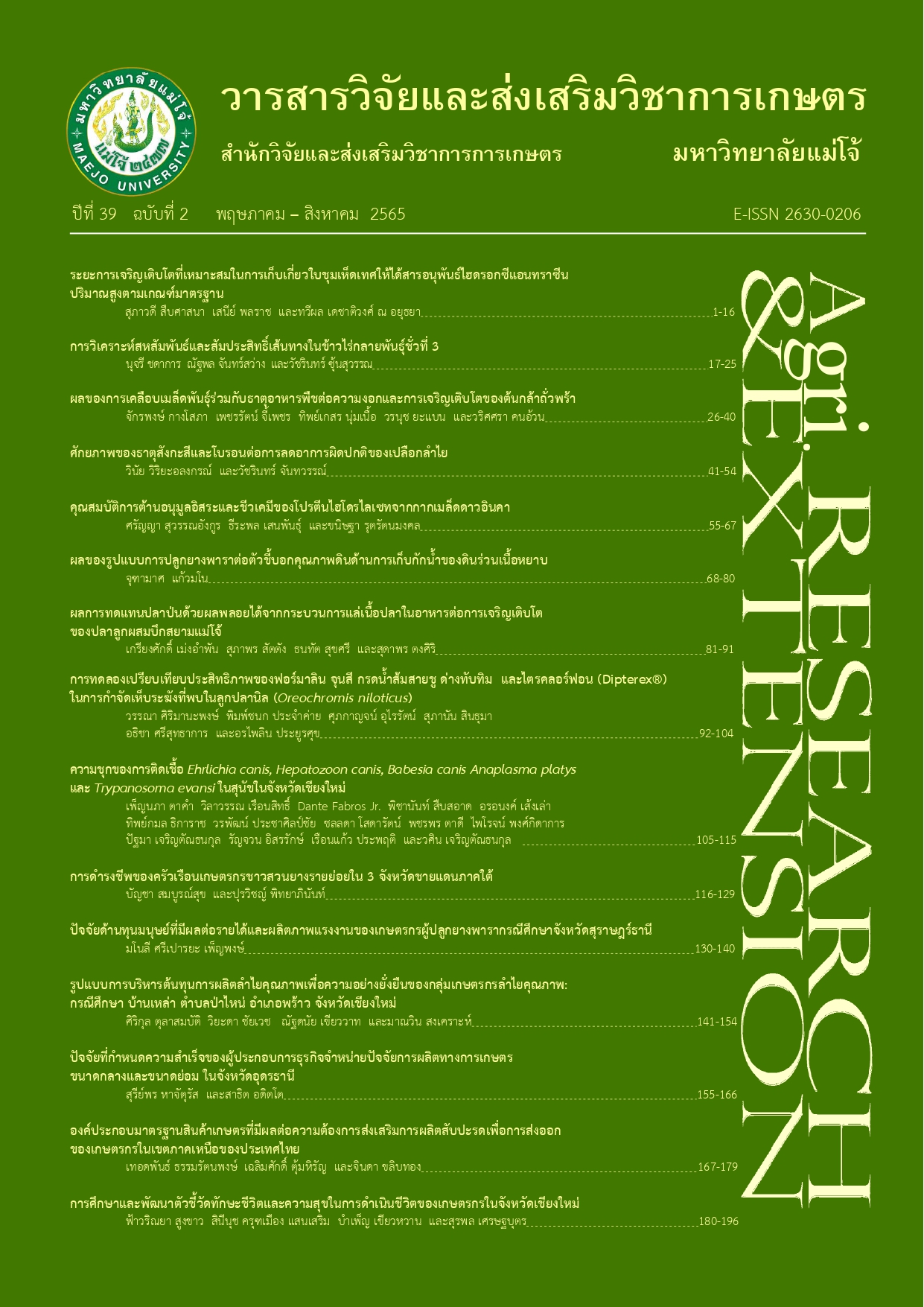การดำรงชีพของครัวเรือนเกษตรกรชาวสวนยางรายย่อยใน 3 จังหวัดชายแดนภาคใต้
คำสำคัญ:
การดำรงชีพ, เกษตรกรผู้ปลูกยางพารารายย่อย , จังหวัดชายแดนภาคใต้บทคัดย่อ
งานวิจัยนี้มีวัตถุประสงค์เพื่อศึกษาการดำรงชีพของครัวเรือนเกษตรกรชาวสวนยางรายย่อยใน 3 จังหวัดชายแดนภาคใต้ ได้แก่ จังหวัดยะลา นราธิวาส และปัตตานี รวบรวมข้อมูลปฐมภูมิด้วยแบบสัมภาษณ์เชิงโครงสร้าง การสังเกตแบบไม่มีส่วนร่วม และการสนทนาตามธรรมชาติกับเกษตรกรชาวสวนยางรายย่อยจำนวน 313 ราย ซึ่งใช้การเลือกตัวอย่างแบบเจาะจง การวิเคราะห์ข้อมูลใช้สถิติเชิงพรรณนา ได้แก่ ค่าร้อยละ ค่าเฉลี่ย และการวิเคราะห์เนื้อหาที่ปรากฏ ผลการวิจัยพบว่า แนวโน้มการเปลี่ยนแปลงทางทรัพยากรธรรมชาติและสิ่งแวดล้อมส่งผลมากที่สุดต่อการดำรงชีพของครัวเรือนเกษตรกรชาวสวนยางรายย่อย ครัวเรือนเกษตรกรชาวสวนยางรายย่อยมีทุนในการดำรงชีพโดยภาพรวมระดับปานกลาง ครัวเรือนเกษตรกรชาวสวนยางรายย่อยมากกว่าครึ่งได้รับความช่วยเหลือจากหน่วยงานภาครัฐที่เกี่ยวข้อง กลยุทธ์ในการดำรงชีพที่สำคัญของครัวเรือนเกษตรกรชาวสวนยางรายย่อยคือ การปรับตัวด้านสังคม ครัวเรือนเกษตรกรชาวสวนยางรายย่อยมีผลลัพธ์ในการดำรงชีพโดยภาพรวมระดับปานกลาง ผลการวิจัยที่ได้จะเป็นข้อมูลที่มีประโยชน์ต่อผู้กำหนดนโยบายของหน่วยงานภาครัฐที่เกี่ยวข้องสำหรับกำหนดนโยบายที่เหมาะสม เช่น เพิ่มความหลากหลายของกิจกรรมการผลิตทางการเกษตร สร้างทางเลือกในการประกอบอาชีพทั้งในและนอกภาคการเกษตร ให้ความรู้ ในเรื่องที่เหมาะสม
เอกสารอ้างอิง
Chantavanich, S. 2007. Qualitative Research Methods. 10th ed. Bangkok: Darnsutha Press. 233 p. [in Thai]
Charernjiratragul, S., A. Romyen and P. Satsue. 2017. Development of rubber-based intercropping system in southern Thailand: problems and obstacles. Kasetsart Journal of Social Sciences 38(2): 588-599. [in Thai]
Cronbach, L.J. 1990. Essentials of Psychological Testing. 5th ed. New York: HarperCollins. 726 p.
Deep South Watch. 2021. Summary of incidents in Southern Thailand, December 2020. [Online]. Available https://dswdatabase.info/wp-content/uploads/2021/01/DATASHEET-122020-EN.pdf (3 February 2021).
Department of Agricultural Extension. 2020. Report of para-rubber farmer household in Yala, Narathiwat, and Pattani provinces 2019. (Unpublished Document). [in Thai]
Department for International Development (DFID). 1999. Sustainable Livelihoods Guidance Sheets. London: Department for International Development. 36 p.
Fongmul, S. 2020. Effects of shortage of agricultural workers on food security in Chiang Mai. Journal of Agricultural Research and Extension 37(1): 118-125. [in Thai]
Junkaew, A. 2010. Livelihoods of Rubber Unsmoked Sheet Producing Households and Rubber Latex Producing Households: A Case Study of Namorbun Sub-district, Chulaporn District, Nakhon Si Thammarat Province. Master Thesis. Prince of Songkla University. 237 p. [in Thai]
Kaewtathip, W. 2017. The suffering of rubber farmers in three southern border provinces of Thailand. Khon Kaen Agriculture Journal 45(4): 693-702. [in Thai]
Kispredarborisuthi, B. 2006. Developing Techniques of Data Collection Instruments for Research. 6th ed. Bangkok: Chamchuree Products. 302 p. [in Thai]
Leisinger, K.M., K.M. Schmitt and R. Pandya-Lorch. 2002. Six Billion and Counting: Population Growth and Food Security in the 21st Century. Washington, D.C.: International Food Policy Research Institute. 155 p.
Longpichai, O. and C. Kongmanee. 2019. Rubber farmers’ risk perception in Southern Thailand. Parichart Journal, Thaksin University 32(2): 134-146. [in Thai]
Masae, A. 2015. Enhancing sustainable rural livelihood through community-based development. Journal of Social Development 17(1): 89-110. [in Thai]
Ministry of Agriculture and Cooperatives. 2016. The Agricultural Development Plan under the Twelfth National Economic and Social Development Plan (2017–2021). Bangkok: Ministry of Agriculture and Cooperatives. 66 p. [in Thai]
Mulha, S., T. Satun, M. Phuworakij, P. Tabsombat and T. Chalermsuk. 2015. Strategies used by residents of agricultural households in Bankhamphai, Muang district, Kalasin province to maintain their livelihoods. Prae-wa Kalasin Journal of Kalasin University 2(1): 80–111. [in Thai]
National Statistical Office. 2020. Head count index (expenditure) by region and province: 2009–2018. [Online]. Available http://statbbi.nso.go.th /staticreport/page/sector/th/08.aspx (5 May 2020). [in Thai]
National Statistical Office. 2021. General consumer price index by province and commodity group (base year 2015): 2010–2019. [Online]. Available http://statbbi.nso.go.th/ staticreport/page/sector/th/14.aspx (2 February 2021). [in Thai]
Nunnally, J.C. 1978. Psychometric Theory. 2nd ed. New York: McGraw-Hill. 677 p.
Office of Agricultural Economics. 2020. Agricultural statistics of Thailand 2019. [Online]. Available http://www.oae.go.th/ assets/portals/1/files/jounal/2563/yearbook62edit.pdf (18 June 2020). [in Thai]
Palee, J. and A. Anantanathon. 2020. The security-approach for enhancing agriculturalist surviving in industrial area of Thailand. Journal of Local Governance and Innovation 4(1): 199-216. [in Thai]
Promphakping, B. 2012. Wellbeing. Humanities and Social Sciences 29(2): 23-50. [in Thai]
Satsue, P. and P. Phitthayaphinant. 2018. Factors related to change in quality of life of para-rubber farmers from low para-rubber prices problem in Srinakharin district, Phatthalung province. Journal of Humanities and Social Sciences, Mahasarakham University 37(3): 71-84. [in Thai]
Singhapreecha, C. 2015. The impact of agricultural demographic structural change on food security in Thai agricultural sector. Journal of the Association of Researchers 20(1): 107-121. [in Thai]
Sinthipong, U. 2015. Local community and the participation in the management of natural resources for sustainable use. Executive Journal 35(1): 104-113. [in Thai]
Smithikrai, C. 2011. Industrial and Organizational Psychology. Bangkok: V. Print (1991). 455 p. [in Thai]
Songsom, A. 2009. Household economy in Pattani province under the Southern unrest. Journal of Humanities and Social Sciences 5(2): 37-70. [in Thai]
ดาวน์โหลด
เผยแพร่แล้ว
รูปแบบการอ้างอิง
ฉบับ
ประเภทบทความ
สัญญาอนุญาต
ลิขสิทธิ์ (c) 2022 วารสารวิจัยและส่งเสริมวิชาการเกษตร

อนุญาตภายใต้เงื่อนไข Creative Commons Attribution-NonCommercial-NoDerivatives 4.0 International License.
บทความนี้ได้รับการเผยแพร่ภายใต้สัญญาอนุญาต Creative Commons Attribution-NonCommercial-NoDerivatives 4.0 International (CC BY-NC-ND 4.0) ซึ่งอนุญาตให้ผู้อื่นสามารถแชร์บทความได้โดยให้เครดิตผู้เขียนและห้ามนำไปใช้เพื่อการค้าหรือดัดแปลง หากต้องการใช้งานซ้ำในลักษณะอื่น ๆ หรือการเผยแพร่ซ้ำ จำเป็นต้องได้รับอนุญาตจากวารสาร





